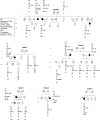DSP p.(Thr2104Glnfs*12) variant presents variably with early onset severe arrhythmias and left ventricular cardiomyopathy
- PMID: 32005173
- PMCID: PMC6995042
- DOI: 10.1186/s12881-020-0955-z
DSP p.(Thr2104Glnfs*12) variant presents variably with early onset severe arrhythmias and left ventricular cardiomyopathy
Abstract
Background: Dilated cardiomyopathy (DCM) is a condition characterized by dilatation and systolic dysfunction of the left ventricle in the absence of severe coronary artery disease or abnormal loading conditions. Mutations in the titin (TTN) and lamin A/C (LMNA) genes are the two most significant contributors in familial DCM. Previously mutations in the desmoplakin (DSP) gene have been associated with arrhythmogenic right ventricular cardiomyopathy (ARVC) and more recently with DCM.
Methods: We describe the cardiac phenotype related to a DSP mutation which was identified in ten unrelated Finnish index patients using next-generation sequencing. Sanger sequencing was used to verify the presence of this DSP variant in the probands' relatives. Medical records were obtained, and clinical evaluation was performed.
Results: We identified DSP c.6310delA, p.(Thr2104Glnfs*12) variant in 17 individuals of which 11 (65%) fulfilled the DCM diagnostic criteria. This pathogenic variant presented with left ventricular dilatation, dysfunction and major ventricular arrhythmias. Two patients showed late gadolinium enhancement (LGE) and myocardial edema on cardiac magnetic resonance imaging (MRI) that may suggest inflammatory process at myocardium.
Conclusions: The patients diagnosed with DCM showed an arrhythmogenic phenotype as well as SCD at young age supporting the recently proposed concept of arrhythmogenic cardiomyopathy. This study also demonstrates relatively low penetrance of truncating DSP variant in the probands' family members by the age of 40. Further studies are needed to elucidate the possible relations between myocardial inflammation and pathogenic DSP variants.
Keywords: Arrhythmogenic cardiomyopathy; Cardiomyopathies; DSP; Dilated cardiomyopathy; Mutation; desmoplakin.
Conflict of interest statement
Minor conflict of interest: TPA, SM, JK are co-founders and TKK, TPA, SM, JK are full-time employees of Blueprint Genetics, which offers genetic diagnostic services.
Figures

Similar articles
-
Desmoplakin Cardiomyopathy, a Fibrotic and Inflammatory Form of Cardiomyopathy Distinct From Typical Dilated or Arrhythmogenic Right Ventricular Cardiomyopathy.Circulation. 2020 Jun 9;141(23):1872-1884. doi: 10.1161/CIRCULATIONAHA.119.044934. Epub 2020 May 6. Circulation. 2020. PMID: 32372669 Free PMC article.
-
Desmoplakin truncations and arrhythmogenic left ventricular cardiomyopathy: characterizing a phenotype.Europace. 2014 Dec;16(12):1838-46. doi: 10.1093/europace/euu128. Epub 2014 Jun 17. Europace. 2014. PMID: 24938629
-
Imaging features of desmoplakin arrhythmogenic cardiomyopathy: A comparative cardiovascular magnetic resonance study.J Cardiovasc Magn Reson. 2025 Summer;27(1):101867. doi: 10.1016/j.jocmr.2025.101867. Epub 2025 Feb 26. J Cardiovasc Magn Reson. 2025. PMID: 40021092 Free PMC article.
-
A 45-year-old man with sudden cardiac death, cutaneous abnormalities and a rare desmoplakin mutation: a case report and literature review.BMC Cardiovasc Disord. 2022 Feb 12;22(1):41. doi: 10.1186/s12872-022-02472-5. BMC Cardiovasc Disord. 2022. PMID: 35151254 Free PMC article. Review.
-
Missense variants in the spectrin repeat domain of DSP are associated with arrhythmogenic cardiomyopathy: A family report and systematic review.Am J Med Genet A. 2020 Oct;182(10):2359-2368. doi: 10.1002/ajmg.a.61799. Epub 2020 Aug 18. Am J Med Genet A. 2020. PMID: 32808748
Cited by
-
Case Report: A novel desmoplakin mutation in a taiwanese woman with familial dilated cardiomyopathy that necessitated heart transplantation.Front Genet. 2022 Sep 23;13:954931. doi: 10.3389/fgene.2022.954931. eCollection 2022. Front Genet. 2022. PMID: 36212137 Free PMC article.
-
Arrhythmogenic left ventricular cardiomyopathy caused by a novel likely pathogenic DSP mutation, p.K1165Rfs*8, in a family with sudden cardiac death.BMC Med Genomics. 2023 Oct 26;16(1):266. doi: 10.1186/s12920-023-01701-w. BMC Med Genomics. 2023. PMID: 37885024 Free PMC article.
-
Crucial Role of Mammalian Glutaredoxin 3 in Cardiac Energy Metabolism in Diet-induced Obese Mice Revealed by Transcriptome Analysis.Int J Biol Sci. 2021 Jul 13;17(11):2871-2883. doi: 10.7150/ijbs.60263. eCollection 2021. Int J Biol Sci. 2021. PMID: 34345213 Free PMC article.
-
DSP c.6310delA p.(Thr2104Glnfs*12) associates with arrhythmogenic cardiomyopathy, increased trabeculation, curly hair, and palmoplantar keratoderma.Front Cardiovasc Med. 2023 Mar 15;10:1130903. doi: 10.3389/fcvm.2023.1130903. eCollection 2023. Front Cardiovasc Med. 2023. PMID: 37008330 Free PMC article.
-
Whole-Exome Sequencing Identified a Novel Variant (C.405_422+39del) in DSP Gene in an Iranian Pedigree with Familial Dilated Cardiomyopathy.Rep Biochem Mol Biol. 2021 Jul;10(2):280-287. doi: 10.52547/rbmb.10.2.280. Rep Biochem Mol Biol. 2021. PMID: 34604417 Free PMC article.
References
-
- Elliott P, Andersson B, Arbustini E, Bilinska Z, Cecchi F, Charron P, et al. Classification of the cardiomyopathies: A position statement from the european society of cardiology working group on myocardial and pericardial diseases. Eur Heart J. 2008;29(2):270–276. doi: 10.1093/eurheartj/ehm342. - DOI - PubMed
Publication types
MeSH terms
Substances
Supplementary concepts
LinkOut - more resources
Full Text Sources
Miscellaneous

